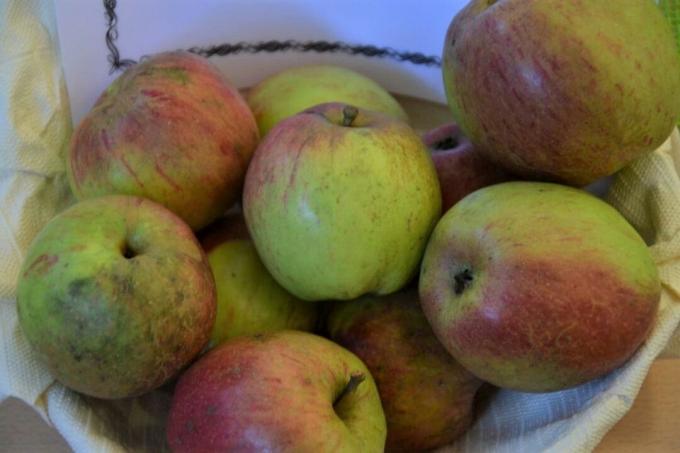If you are looking for an uncomplicated and naturally healthy apple variety for your garden, the 'Rheinische Krummstiel' is just right for you. We present the old apple variety and give tips on cultivation, care and harvest.

'Rheinische Krummstiel' is an old German variety that is perfect for home gardens because of its general hardiness and versatility. However, if you want to welcome this uncomplicated and tasty apple to your garden, you should have plenty of space due to its vigorous growth or regularly use scissors.
contents
- Rhenish crooked handle: profile
- history and origin
- Crookstalk apple: characteristics, taste and appearance
- Cultivation and care of the apple variety 'Rheinischer Krummstiel'
- Harvesting and use of the apple
Rhenish crooked handle: profile
| fruit | medium to large; Greenish to lemon yellow base color with cloudy to bright red top colour |
| the taste | juicy, sweet wine-sour, aromatic |
| yield | high and regular |
| harvest time | from October on |
| maturity | since December |
| shelf life | very good; can be stored until May |
| growth | initially strong, later medium strong |
| climate | prefers warm locations and a maritime climate; also tolerates high altitudes |
| diseases and pests | susceptible to powdery mildew in unfavorable locations |
history and origin
Not much is known about the history of the 'Rheinische Krummstiel'. Various sources agree that the variety must be over 200 years old and originated somewhere between Cologne and Bonn. In 1828 the 'Rheinische Krummstiel' was described pomologically for the first time by Adrian Diel (*1756, † 1838), the founder of pomology in Germany. Today, the variety is found more frequently in Styria, which is probably due to the fact that it tolerates the prevailing climate particularly well.
Crookstalk apple: characteristics, taste and appearance
The 'Rheinische Krummstiel' is medium to large in size and can take different forms: sometimes it is thickened on one side, sometimes egg-shaped, barrel-shaped, spherical and flattened or else roller cone shaped. The basic color of the fine, matt-shiny skin is greenish-yellow when ripe and later becomes lemon-yellow. An incomplete, dull or bright red, striped or flamed top color develops on the sunny side or on the whole fruit.
The name of the variety is explained by looking at the stem pit. It is narrow and often has a fleshy nose that pushes aside the thick, knobbly short stem. The flesh under the thin skin is still greenish-yellow and very firm when ripe, and becomes almost white as it ripens. With its rather fine texture, the juicy mouthfeel and the aromatic, sweet wine-sour taste, the flesh is very delicate. Even when not bitten, the fruit gives off a noticeable, sweet scent.
Cultivation and care of the apple variety 'Rheinischer Krummstiel'
The apple variety 'Rheinischer Krummstiel' is a good choice for many home gardens: it does not make great demands on the soil. This can be humus, loamy or a little heavier and richer in tone. Only extremely light and sandy soils should be covered extensively with plenty of mature compost or a high-quality potting soil such as our peat-free Plantura organic universal soil be improved. Warm locations are preferred, but high altitudes, for example on a south-west or south-east slope, are also well tolerated. The 'Rheinischer Krummstiel' variety loves higher humidity and therefore thrives particularly well in a maritime climate.

The growth of the 'Rheinsichen Krummstiel' is strong when young, later medium strong. Regardless of age, this strain branches poorly. An occasional pruning to provoke the emergence of side buds is therefore appropriate. In this way, young fruit wood is always generated. With age, the crown of uncut 'Rheinischer Krummstiel' becomes broad and overhanging. This looks particularly picturesque, but ensures that the trees are not street trees. The crown can also become a nuisance when mowing in the garden. This growth behavior also suggests that the variety should be cut occasionally.
The old variety can enrich extensively cultivated orchards as a standard tree on its own roots, or grafted on seedling rootstock, where it can almost be left to its own devices. The 'Rheinische Krummstiel' can also be used as a half or quarter trunk or as a bush tree integrate a home garden: For this purpose, medium-growing rootstocks such as M7 or M4 should be used will. The effort for the cut is then somewhat more important.
The flowering of the 'Rheinische Krummstiel' appears medium late to late, lasts a long time and is not sensitive to frost. Good pollinators are the varieties 'Berner Rosenapfel', 'Cox Orange', 'Croncels', 'Danziger Kantapfel' and the 'gold parmesan‘.
It is very convenient that the apples of the variety stay on the tree for a long time and only fall to the ground after the first frosts. Once the tree has established itself in its place of growth, it bears richly and regularly, if not by a too radical Apple Tree Pruning is thrown out of physiological balance.
The hardy 'Rheinische Krummstiel' is only slightly susceptible to apple scab but can easily be attacked by powdery mildew in areas with a lot of morning dew.
Harvesting and use of the apple
The 'Rheinische Krummstiel' can be harvested and stored from October. However, it only reaches its full maturity in December. If stored in a cool, slightly damp place - for example in an earth cellar - this variety will keep well into May without any problems. During storage, the pulp becomes softer but not crumbly and develops its full aroma. Due to the firm shell, the apple can also be shipped without any problems. It is used as a dessert apple, for cooking or cidering.
An excellent combination for the somewhat more spacious house garden are the 'Rheinische Krummstiel' and the also rather strong-growing and very tasty 'Cox Orange‘. Firstly, the varieties pollinate each other, and secondly, the 'Cox Orange' is ready to eat between October and November.


